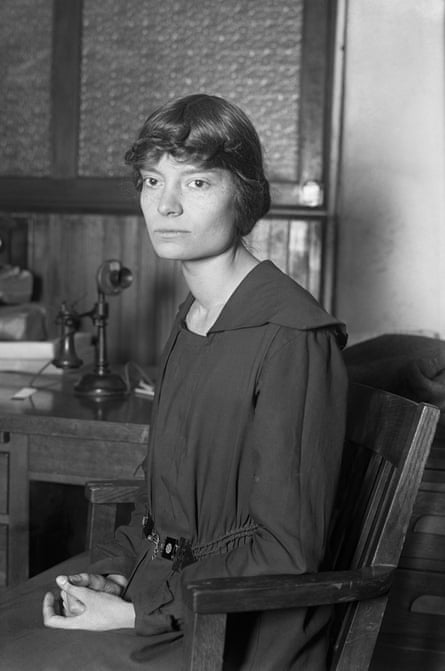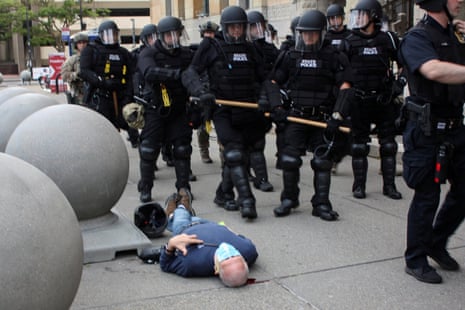In the moments before he was pushed to the sidewalk by a Buffalo police officer and then left for dead, 75-year-old Martin Gugino walked towards the line of advancing police. But why?
“I know exactly what he was doing. I’ve seen him do it a hundred other times,” says his close friend, fellow activist and public defense attorney Matt Daloisio, in a telephone conversation.
“What I think he was doing was trying to offer them something to read on his phone: about the law, about the right of people to assemble. Or asking why they were preventing people from exercising that right.”
Gugino remains in hospital due to the serious head injury he received at the hands of Buffalo police. Daloisio says that although he has left the ICU, he sustained a brain injury, and “it’s not clear what long-term effects that will have”.
Gugino’s presence at the protest and his attempt to engage the police was in keeping with the Catholic Worker Movement, which Gugino and Daloisio are aligned with. The movement takes its position not from a political tract, but from what they see as the most radical passage in the New Testament.
“Different people figure out ways to live out the Beatitudes,” Daloisio says, referring to the precepts outlined in the Sermon on the Mount.
The passage is familiar to anyone who has even a casual acquaintance with Christian teaching: Jesus inverts worldly values to elevate the poor, the sick and the meek. In Sunday school, it might have the force of a platitude, but Catholic Workers take it with the utmost gravity.
Dorothy Day, the co-founder of the movement, described it as their “manifesto”.
Even though the movement – which Daloisio calls “anarchist” – has no binding structure or formal membership, those aligned with it engage in actions to advance peace and justice as they see it, from voluntary poverty in the service of the poor, to protest, to sometimes controversial forms of direct action.

On Tuesday, Donald Trump tweeted out a baseless conspiracy theory, apparently sourced from truth-averse cable news outlet OANN, that Gugino could be “an antifa provocateur” the entire incident “could be a set-up”.
The antifa movement, which Trump has made increasingly strident accusations about on social media, includes many activists who often identify as anarchists, and many who leave open the possibility of physically defending their communities from the far right.
But Daloisio says that “the Catholic Worker anarchism, the Catholic Worker charism” – the spirit of the movement – “is one that is grounded in a deep commitment to non-violence”. One of Gugino’s core beliefs is that “as firmly as we may believe something, we never have any right to to harm another human being”.
Daloisio met Gugino after he and other Catholic Workers founded Witness Against Torture (WAT), which since 2005 has campaigned against torture and indefinite imprisonment of inmates in Guantánamo Bay. Gugino, already a Catholic, became integral to this circle of activists, who are mostly Catholic Workers.
The non-violent direct action WAT has engaged in – hunger strikes, passively shutting down federal courthouses, lining the sidewalk outside the White House in orange jumpsuits – is characteristic of the broader Catholic Worker Movement.
But Daloisio acknowledges that “there is a debate within Catholic Worker circles about what violence is. There are people, some of whom Martin has supported, who have done property destruction. I am representing a group of them now.”
Last week, an 80-year-old former nun and Catholic Worker was sentenced for her part in a 2018 action in which a group of seven like-minded activists broke into a navy base housing nuclear submarines and hundreds of nuclear missiles. The group spilled blood on a navy flag, spray-painted anti-war slogans, and hammered on a sculpture. Other members of the group will be sentenced later this month.
Elsewhere, Catholic Workers have been charged with property crimes over their participation in anti oil-pipeline activism as so-called “valve turners”. In Australia, several Catholic Workers received sentences in 2017 after removing a brass sword from a stone cross at a war memorial.
Of the 2018 action at the naval base, Daloisio says that “some people would consider that violent. I don’t. I don’t think conversion of property that is only in existence to kill other people is a form of violence.”

But he stresses that Gugino was not involved in actions like these. “The man does not have a violent tendency or has never taken a violent action in his life. He is one of the sweetest, gentlest people I know.”
Protests are not the only form of Catholic Worker action. Another is running “houses of hospitality” for the poor. The most committed members themselves live in these communities, as the movement’s founders Day and Peter Maurin did: in voluntary poverty. No house is a tax-exempt charity, because this would bind them to the state. During periods of military conscription, Catholic Workers have been prominent conscientious objectors. They have worked and protested in support of labor unions and anti-racist causes: Black Lives Matter is the latest of these.
According to her recent biographer, Day, the movement’s co-founder, went from bohemian radical leftist journalist to the devout leader of a Catholic social movement without compromising much of her politics.
In a phone conversation, John Loughery, the co-author of Dorothy Day: Dissenting Voice of the American Century, says she was an “anarchist”, and her commitments included “anti-fascism, and also anti-capitalism, anti-racism”.
Her public stances on these issues sometimes sat uneasily with what Loughery calls her desire “to be seen as a good daughter of the church”.
Not long after the movement’s founding in 1933, during the Spanish civil war, Day refused to follow the church’s hierarchy in supporting Franco against the leftist Republican forces, who were mostly atheists, and some of whom killed nuns and priests.
Day “thought both sides were in the wrong”, says Loughery. “The church was wrong in supporting the fascists because they were anti-communist. And then the communists are wrong to be anti-Catholic.”
Above all, as in every controversy she entered, Day advocated peace.
By “not aligning herself with any of these power structures”, Loughery says, she alienated priests and laity, which diminished the circulation of her newspaper, the Catholic Worker, whose advocacy for the poor had made it popular during the Great Depression.
Decades later, in 1966, when Cardinal Francis Spellman, the head of the New York diocese, visited troops in Vietnam to “urge them to total victory against communism”, Loughery says, Day took one of her strongest stands against the church hierarchy. In a piece published in the Catholic Worker in January 1967, she told the Cardinal: “Words are as strong and powerful as bombs, as napalm.”
As Catholic Workers have reacted with shock at the incident of police brutality, Gugino and his lawyers have asked for privacy as he attempts to recover from serious injury.
Daloisio points out that “the one public comment that he did give from his hospital bed was just to say that ‘black lives matter’ – and nothing else.”
But one effect of his sudden prominence as a symbol of protest, Daloisio says, is that “there are lots of pictures floating around of him now. And I would venture to say in every single one, he has a smile on his face. Because he always does.”
